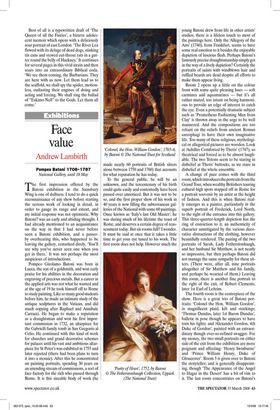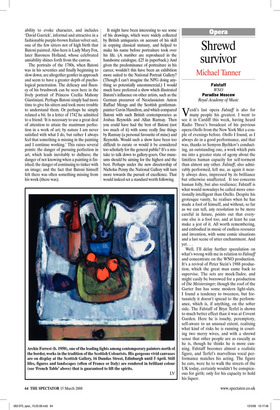Face value
Andrew Lambirth
Pompeo Batoni 1708–1787 National Gallery, until 18 May
The first impression offered by the Batoni exhibition in the Sainsbury Wing is one of dullness. I tend to do a quick reconnaissance of any show before starting the serious work of looking in detail, in order to gauge its range and extent, and my initial response was not optimistic. Why Batoni? was an early and abiding thought. I had already mentioned to an acquaintance on the way in that I had never before seen a Batoni exhibition, and a passerby overhearing this, who happened to be leaving the gallery, remarked direly, ‘You’ll see why you’ve never seen one when you get in there.’ It was not perhaps the most auspicious of introductions.
Pompeo Girolamo Batoni was born in Lucca, the son of a goldsmith, and won early praise for his abilities in the decoration and engraving of precious metals. But a career in the applied arts was not what he wanted and at the age of 19 he took himself off to Rome to study painting. Like so many good students before him, he made an intimate study of the antique sculptures in the Vatican, and did much copying after Raphael and Annibale Carracci. He began to make a reputation as a draughtsman and won his first important commission in 1732, an altarpiece for the Gabrielli family tomb in San Gregorio al Celio. He continued with this kind of work for churches and grand decorative schemes for palaces until his vast and ambitious altarpiece for St Peter’s was exhibited in 1755 and later rejected (there had been plans to turn it into a mosaic). After this he concentrated on painting portraits, spending 30 years on an unending stream of commissions, a sort of face factory for the rich who passed through Rome. It is this sizeable body of work (he made nearly 60 portraits of British sitters alone between 1750 and 1760) that accounts for what reputation he has today.
To the general public, he will be an unknown, and the tercentenary of his birth could quite easily and contentedly have been passed over unnoticed. But it was not to be so, and the first proper show of his work in 40 years is now filling the subterranean galleries of the National with some 60 paintings. Once known as ‘Italy’s last Old Master’, he was during much of his lifetime the toast of Rome, and deserves a certain degree of reassessment today. But six rooms full? I wonder. It must be said at once that it takes a little time to get your eye tuned to his work. The first room does not help. However much the young Batoni drew from life in other artists’ studios, there is a lifeless touch to most of the paintings here. Only the ‘Allegory of the Arts’ (1740), from Frankfurt, seems to have some real emotion to it besides the enjoyable depiction of luscious flesh. Perhaps Batoni’s famously precise draughtsmanship simply got in the way of a lively depiction? Certainly the portraits of saints with windblown hair and ruffled beards are dead despite all efforts to make them appear living.
Room 2 opens up a little on the colour front with some quite pleasing hues — soft carmines and aquamarines — but it’s all rather muted, too intent on being harmonious to provide an edge of interest to catch the eye. Even a potentially dramatic subject such as ‘Prometheus Fashioning Man from Clay’ is thrown away in the urge to be well mannered. And the compositions are too reliant on the reliefs from ancient Roman sarcophagi to have their own imaginative life. Too many of these religious, mythological or allegorical pictures are wooden. Look at ‘Achilles Comforted by Thetis’ (1747), so theatrical and forced as to be almost laughable. The two Tritons seem to be staring in disbelief at Thetis’ buttocks, as we stare in disbelief at the whole ensemble.
A change of pace comes with the third room, which introduces the portraits from the Grand Tour, when wealthy Britishers touring cultural high spots stopped off in Rome for a portrait souvenir by an artist at the height of fashion. And this is when Batoni really emerges as a painter, particularly in the superb portrait of Frederick, Lord North, to the right of the entrance into this gallery. This three-quarter-length depiction has the ring of conviction to it, an authenticity of character unmitigated by the various decorative distractions of the clothing, however beautifully rendered. The pairing of the two portraits of Sarah, Lady Fetherstonhaugh, and her husband Sir Matthew, is not nearly so impressive, but then perhaps Batoni did not manage the same sympathy for these sitters. (There were, after all, nine portraits altogether of Sir Matthew and his family, and perhaps he wearied of them.) Leaving this room, there is another fine portrait to the right of the exit, of Robert Clements, later 1st Earl of Leitrim.
The fourth room is the centrepiece of the show. Here is a great trio of Batoni portraits: ‘Colonel the Hon. William Gordon’, in magnificent plaid, kilt and stockings; ‘Thomas Dundas, later 1st Baron Dundas’, balletic in pose though he appears to have torn his tights; and ‘Alexander Gordon, 4th Duke of Gordon’, painted with an extraordinary though ever-so-refined swagger. For my money, the two small portraits on either side of the exit from the exhibition are more poignant and affecting: ‘Henry Swinburne’ and ‘Prince William Henry, Duke of Gloucester’. Room 5 is given over to Batoni the storyteller, and is generally disappointing, though ‘The Appearance of the Angel to Hagar in the Desert’ has a bit of vim to it. The last room concentrates on Batoni’s ability to evoke character, and includes ‘David Garrick’, informal and attractive in a fashionable purple-brown Italian velvet suit, one of the few sitters not of high birth that Batoni painted. Also here is Lady Mary Fox, later Baroness Holland, whose celebrated amiability shines forth from the canvas.
The portraits of the 1780s, when Batoni was in his seventies and finally beginning to slow down, are altogether gentler in approach and seem to have a greater depth of psychological penetration. The delicacy and fluency of his brushwork can be seen here in the lively portrait of Princess Cecilia Mahony Giustiniani. Perhaps Batoni simply had more time to give his sitters and took more trouble to understand them. Or perhaps he simply relaxed a bit. In a letter of 1742 he admitted to a friend: ‘It is necessary to use a great deal of attention to attain the maximum perfection in a work of art; by nature I am never satisfied with what I do, but rather I always feel that something is missing in the painting and I continue working.’ This raises several points: the danger of pursuing perfection in art, which leads inevitably to dullness; the danger of not knowing when a painting is finished; the danger of continuing to tinker with an image; and the fact that Batoni himself felt there was often something missing from his work (there was). It might have been interesting to see some of his drawings, which were widely collected by British antiquaries on account of his skill in copying classical statuary, and helped to make his name before portraiture took over his life. (A number are reproduced in the handsome catalogue, £25 in paperback.) And given the predominance of portraiture in his career, wouldn’t this have been an exhibition more suited to the National Portrait Gallery? (Though I can’t imagine the NPG doing anything so potentially uncommercial.) I would much have preferred a show which illustrated Batoni’s influence on other artists, such as the German precursor of Neoclassicism Anton Raffael Mengs and the Scottish gentlemanpainter Gavin Hamilton, and which compared Batoni with such British contemporaries as Joshua Reynolds and Allan Ramsay. Then you could have had the best of Batoni (not too much of it) with some really fine things by Ramsay (a personal favourite of mine) and Reynolds. Would such a show have been too difficult to curate or would it be considered too scholarly for the general public? It’s a mistake to talk down to gallery-goers. Our museums should be aiming for the highest and the best. Perhaps under the new directorship of Nicholas Penny the National Gallery will turn more towards the pursuit of excellence. That would indeed set a standard worth following.



























































































 Previous page
Previous page